Abstract
Carboxymethylation using 14C- or 3H-labelled iodoacetic acid has been used to identify the cysteine residues in bovine rhodopsin involved in the formation of the two intramolecular disulphide bridges. Iodo[2-14C]acetic acid was used to modify 5.8-5.9 residues of cysteine under non-reducing conditions. After dialysis and reduction of disulphide bridges by 2-mercaptoethanol, iodo[2-3H]acetic acid was employed to covalently modify 3.3-3.6 residues of cysteine. Peptide purification and sequencing has unambiguously shown that cysteine residues 322 and 323 are only carboxymethylated after reduction of disulphide bridges. Indirect evidence presented, now coupled with the earlier finding [Findlay & Pappin (1986) Biochem. J. 238, 625-642] suggests that the other disulphide bridge is formed between cysteine residues 110 and 187. A comparison is made of all the sequences of mammalian rhodopsins and colour pigments and attention is drawn to the fact that whereas Cys-322 and Cys-323 are conserved only in three rhodopsins (bovine, ovine and human), the residues corresponding to Cys-110 and Cys-187 are found in all the visual proteins (from rods as well as human cones).
Full text
PDF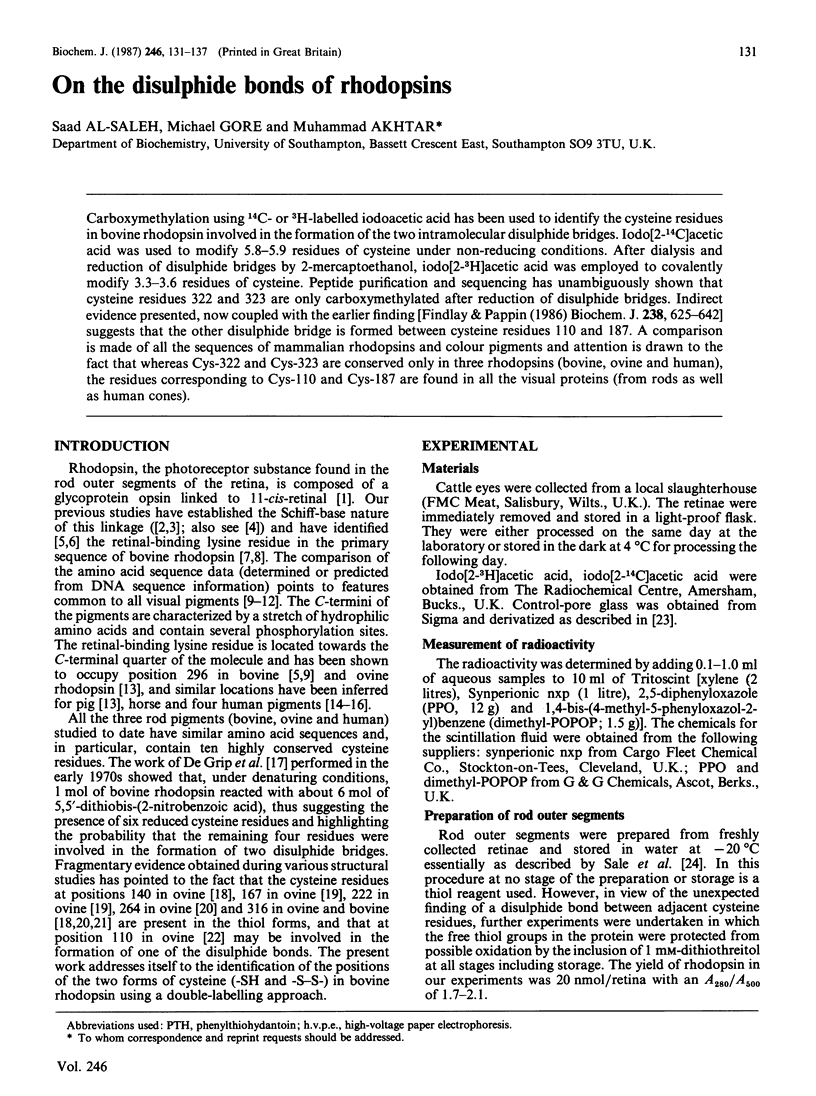
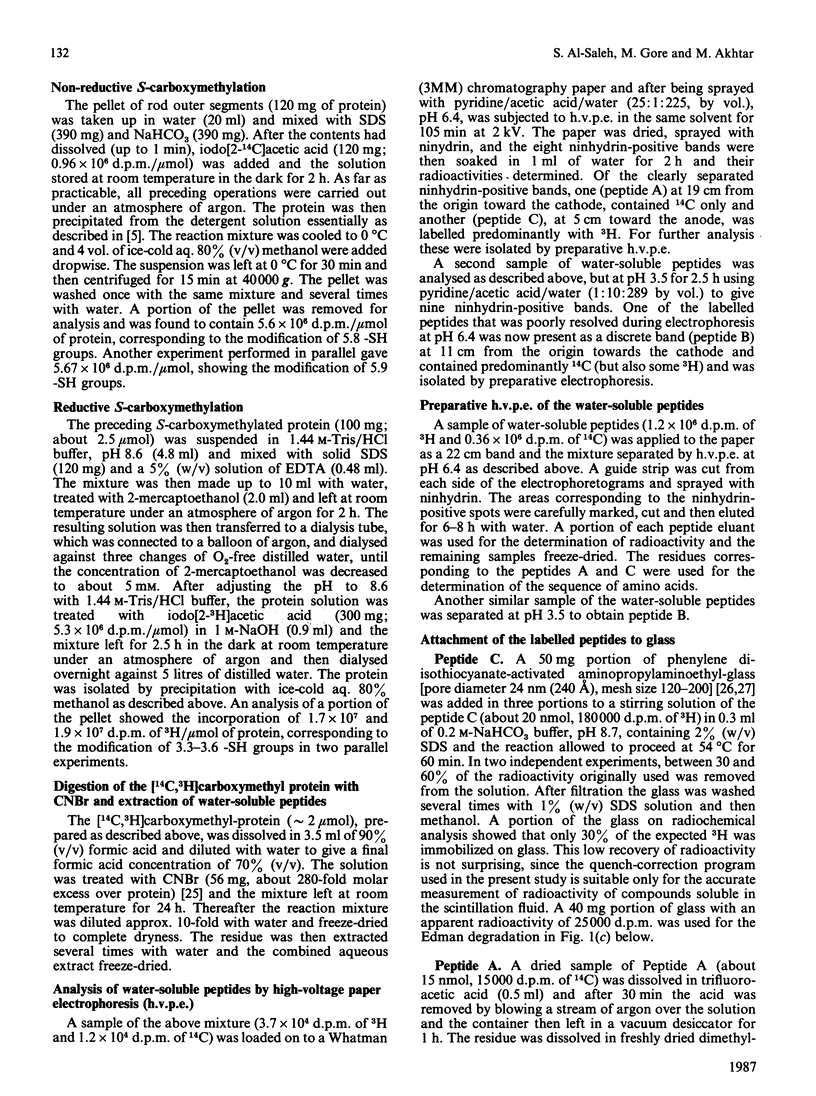
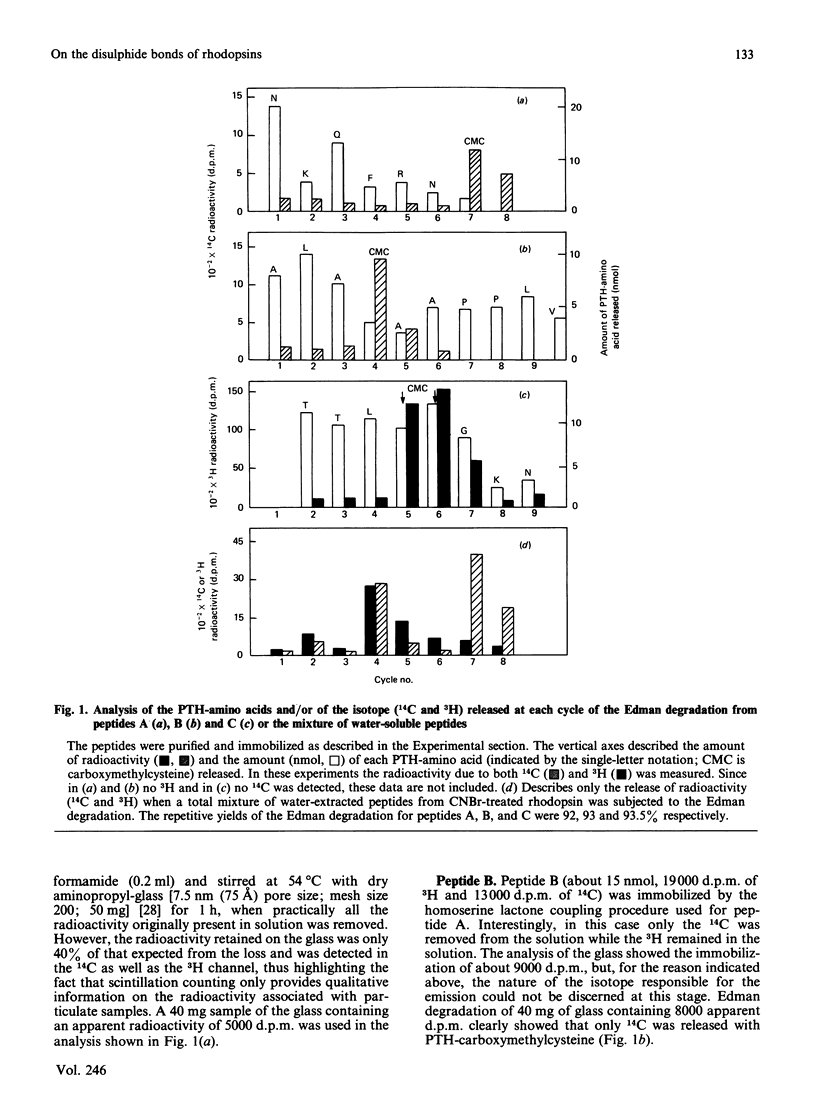
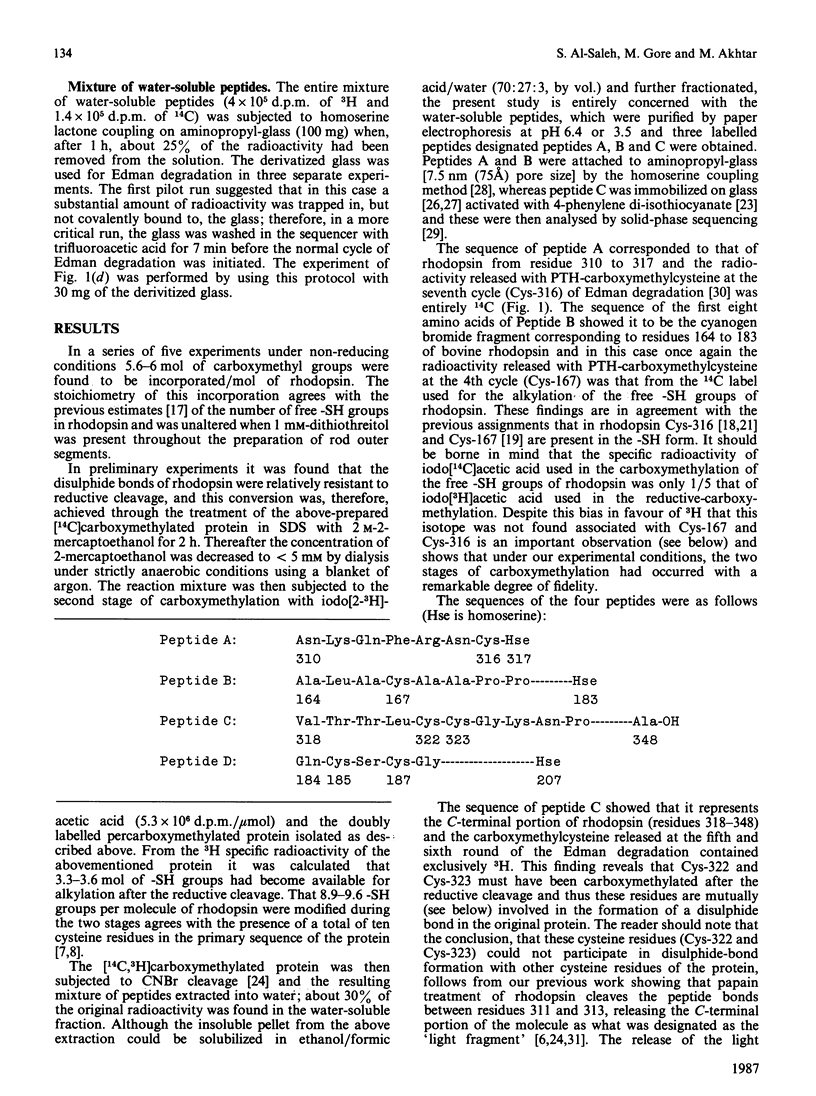
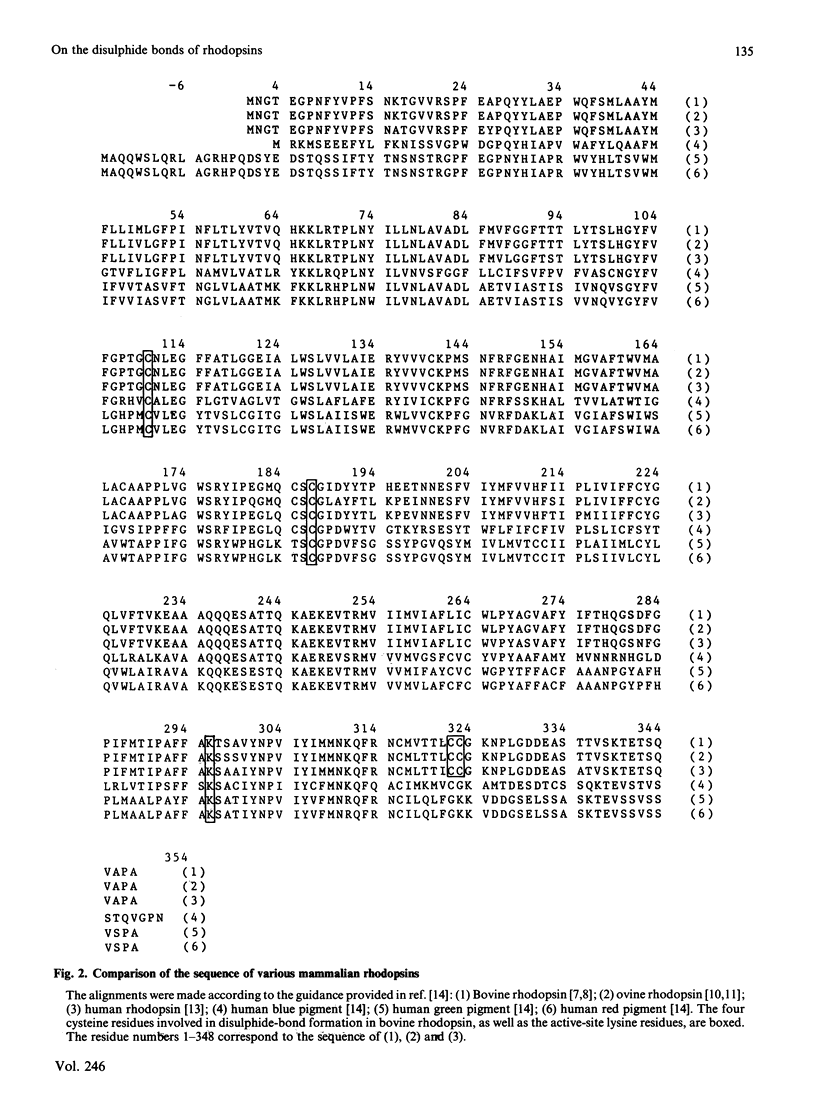
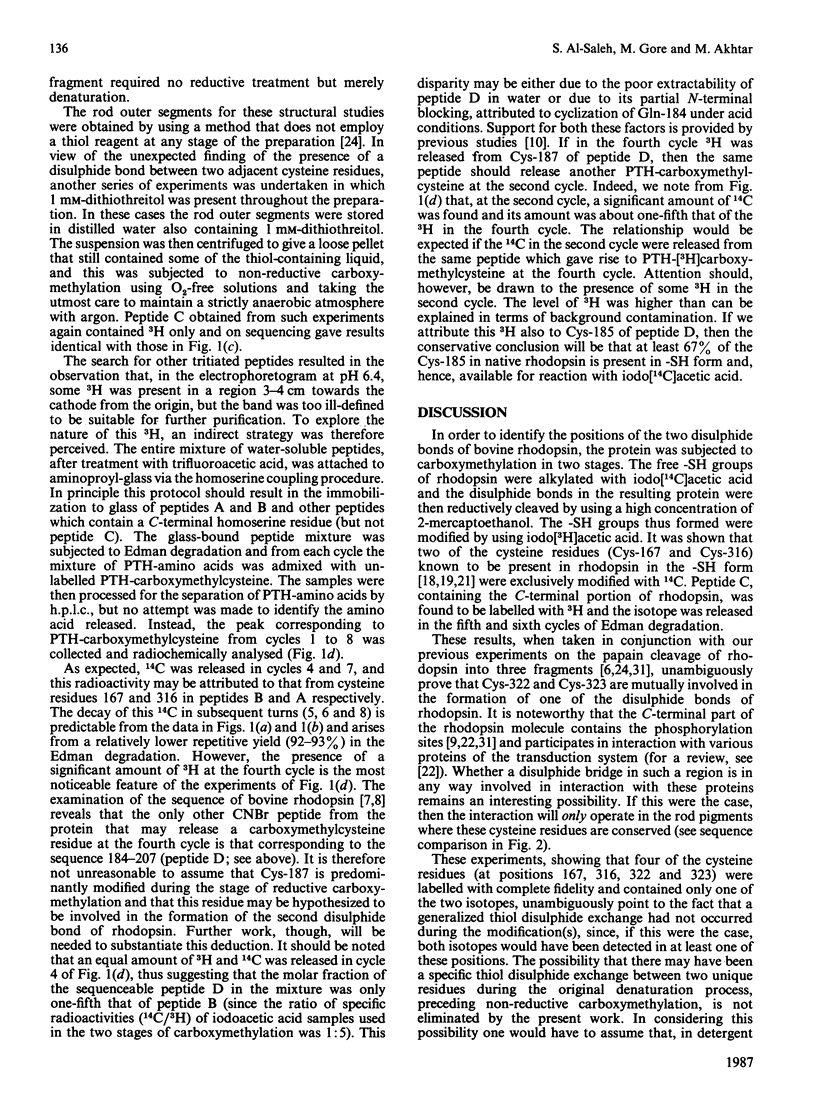
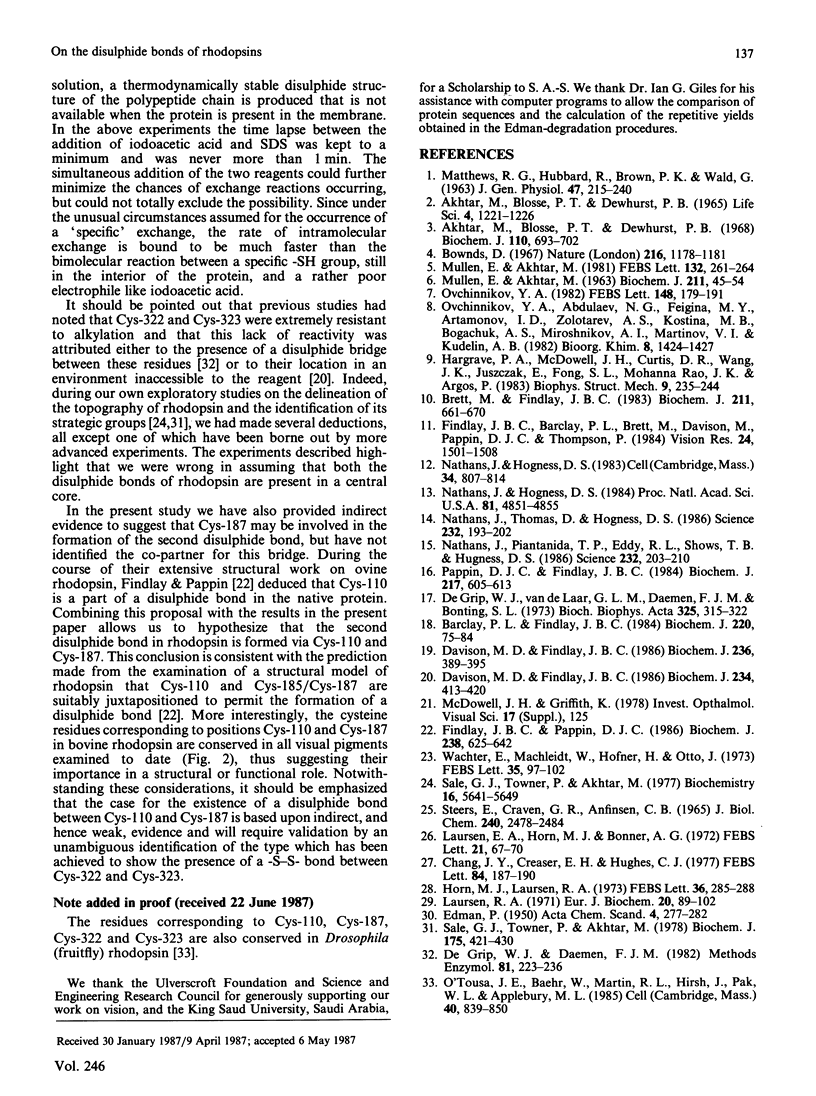
Selected References
These references are in PubMed. This may not be the complete list of references from this article.
- Akhtar M., Blosse P. T., Dewhurst P. B. Studies on vision. The nature of the retinal-opsin linkage. Biochem J. 1968 Dec;110(4):693–702. doi: 10.1042/bj1100693. [DOI] [PMC free article] [PubMed] [Google Scholar]
- Akhtar M., Blosse P. T., Dewhurst P. B. The reduction of a rhodopsin derivative. Life Sci. 1965 Jun;4(12):1221–1226. doi: 10.1016/0024-3205(65)90336-x. [DOI] [PubMed] [Google Scholar]
- Barclay P. L., Findlay J. B. Labelling of the cytoplasmic domains of ovine rhodopsin with hydrophilic chemical probes. Biochem J. 1984 May 15;220(1):75–84. doi: 10.1042/bj2200075. [DOI] [PMC free article] [PubMed] [Google Scholar]
- Bownds D. Site of attachment of retinal in rhodopsin. Nature. 1967 Dec 23;216(5121):1178–1181. doi: 10.1038/2161178a0. [DOI] [PubMed] [Google Scholar]
- Brett M., Findlay J. B. Isolation and characterization of the CNBr peptides from the proteolytically derived N-terminal fragment of ovine opsin. Biochem J. 1983 Jun 1;211(3):661–670. doi: 10.1042/bj2110661. [DOI] [PMC free article] [PubMed] [Google Scholar]
- Chang J. Y., Creaser E. H., Hughes G. J. Improved coupling of proteins to the support for solid phase protein sequencing. FEBS Lett. 1977 Dec 1;84(1):187–190. doi: 10.1016/0014-5793(77)81086-7. [DOI] [PubMed] [Google Scholar]
- Davison M. D., Findlay J. B. Identification of the sites in opsin modified by photoactivated azido[125I]iodobenzene. Biochem J. 1986 Jun 1;236(2):389–395. doi: 10.1042/bj2360389. [DOI] [PMC free article] [PubMed] [Google Scholar]
- Davison M. D., Findlay J. B. Modification of ovine opsin with the photosensitive hydrophobic probe 1-azido-4-[125I]iodobenzene. Labelling of the chromophore-attachment domain. Biochem J. 1986 Mar 1;234(2):413–420. doi: 10.1042/bj2340413. [DOI] [PMC free article] [PubMed] [Google Scholar]
- De Grip W. J., Daemen F. J. Sulfhydryl chemistry of rhodopsin. Methods Enzymol. 1982;81:223–236. doi: 10.1016/s0076-6879(82)81035-5. [DOI] [PubMed] [Google Scholar]
- Findlay J. B., Barclay P. L., Brett M., Davison M., Pappin D. J., Thompson P. The structure of mammalian rod opsins. Vision Res. 1984;24(11):1501–1508. doi: 10.1016/0042-6989(84)90312-2. [DOI] [PubMed] [Google Scholar]
- Findlay J. B., Pappin D. J. The opsin family of proteins. Biochem J. 1986 Sep 15;238(3):625–642. doi: 10.1042/bj2380625. [DOI] [PMC free article] [PubMed] [Google Scholar]
- Hargrave P. A., McDowell J. H., Curtis D. R., Wang J. K., Juszczak E., Fong S. L., Rao J. K., Argos P. The structure of bovine rhodopsin. Biophys Struct Mech. 1983;9(4):235–244. doi: 10.1007/BF00535659. [DOI] [PubMed] [Google Scholar]
- Horn M. J., Laursen R. A. Solid-phase edman degradation: attachment of carboxyl-terminal homoserine peptides to an insoluble resin. FEBS Lett. 1973 Nov 1;36(3):285–288. doi: 10.1016/0014-5793(73)80392-8. [DOI] [PubMed] [Google Scholar]
- Laursen R. A., Horn M. J., Bonner A. G. Solid-phase Edman degradation. The use of p-phenyl diisothiocyanate to attach lysine- and arginine-containing peptides to insoluble resins. FEBS Lett. 1972 Mar;21(1):67–70. doi: 10.1016/0014-5793(72)80165-0. [DOI] [PubMed] [Google Scholar]
- Laursen R. A. Solid-phase Edman degradation. An automatic peptide sequencer. Eur J Biochem. 1971 May 11;20(1):89–102. doi: 10.1111/j.1432-1033.1971.tb01366.x. [DOI] [PubMed] [Google Scholar]
- MATTHEWS R. G., HUBBARD R., BROWN P. K., WALD G. TAUTOMERIC FORMS OF METARHODOPSIN. J Gen Physiol. 1963 Nov;47:215–240. doi: 10.1085/jgp.47.2.215. [DOI] [PMC free article] [PubMed] [Google Scholar]
- Mullen E., Akhtar M. Structural studies on membrane-bound bovine rhodopsin. Biochem J. 1983 Apr 1;211(1):45–54. doi: 10.1042/bj2110045. [DOI] [PMC free article] [PubMed] [Google Scholar]
- Mullen E., Akhtar M. Topographic and active-site studies on bovine rhodopsin. FEBS Lett. 1981 Sep 28;132(2):261–264. doi: 10.1016/0014-5793(81)81174-x. [DOI] [PubMed] [Google Scholar]
- Nathans J., Hogness D. S. Isolation and nucleotide sequence of the gene encoding human rhodopsin. Proc Natl Acad Sci U S A. 1984 Aug;81(15):4851–4855. doi: 10.1073/pnas.81.15.4851. [DOI] [PMC free article] [PubMed] [Google Scholar]
- Nathans J., Hogness D. S. Isolation, sequence analysis, and intron-exon arrangement of the gene encoding bovine rhodopsin. Cell. 1983 Oct;34(3):807–814. doi: 10.1016/0092-8674(83)90537-8. [DOI] [PubMed] [Google Scholar]
- Nathans J., Piantanida T. P., Eddy R. L., Shows T. B., Hogness D. S. Molecular genetics of inherited variation in human color vision. Science. 1986 Apr 11;232(4747):203–210. doi: 10.1126/science.3485310. [DOI] [PubMed] [Google Scholar]
- Nathans J., Thomas D., Hogness D. S. Molecular genetics of human color vision: the genes encoding blue, green, and red pigments. Science. 1986 Apr 11;232(4747):193–202. doi: 10.1126/science.2937147. [DOI] [PubMed] [Google Scholar]
- O'Tousa J. E., Baehr W., Martin R. L., Hirsh J., Pak W. L., Applebury M. L. The Drosophila ninaE gene encodes an opsin. Cell. 1985 Apr;40(4):839–850. doi: 10.1016/0092-8674(85)90343-5. [DOI] [PubMed] [Google Scholar]
- Ovchinnikov YuA Rhodopsin and bacteriorhodopsin: structure-function relationships. FEBS Lett. 1982 Nov 8;148(2):179–191. doi: 10.1016/0014-5793(82)80805-3. [DOI] [PubMed] [Google Scholar]
- Pappin D. J., Findlay J. B. Sequence variability in the retinal-attachment domain of mammalian rhodopsins. Biochem J. 1984 Feb 1;217(3):605–613. doi: 10.1042/bj2170605. [DOI] [PMC free article] [PubMed] [Google Scholar]
- STEERS E., Jr, CRAVEN G. R., ANFINSEN C. B., BETHUNE J. L. EVIDENCE FOR NONIDENTICAL CHAINS IN THE BETA-GALACTOSIDASE OF ESCHERICHIA COLI K12. J Biol Chem. 1965 Jun;240:2478–2484. [PubMed] [Google Scholar]
- Sale G. J., Towner P., Akhtar M. Functional rhodopsin complex consisting of three noncovalently linked fragments. Biochemistry. 1977 Dec 13;16(25):5641–5649. doi: 10.1021/bi00644a040. [DOI] [PubMed] [Google Scholar]
- Sale G. J., Towner P., Akhtar M. Topography of the rhodopsin molecule. Identification of the domain phosphorylated. Biochem J. 1978 Nov 1;175(2):421–430. doi: 10.1042/bj1750421. [DOI] [PMC free article] [PubMed] [Google Scholar]
- Wachter E., Machleidt W., Hofner H., Otto J. Aminopropyl glass and its p-phenylene diisothiocyanate derivative, a new support in solid-phase Edman degradation of peptides and proteins. FEBS Lett. 1973 Sep 1;35(1):97–102. doi: 10.1016/0014-5793(73)80585-x. [DOI] [PubMed] [Google Scholar]
- de Grip W. J., van de Laar G. L., Daemen F. J., Bonting S. L. Biochemical aspects of the visual process. 23. Sulfhydryl groups and rhodopsin photolysis. Biochim Biophys Acta. 1973 Nov 22;325(2):315–322. doi: 10.1016/0005-2728(73)90107-2. [DOI] [PubMed] [Google Scholar]


